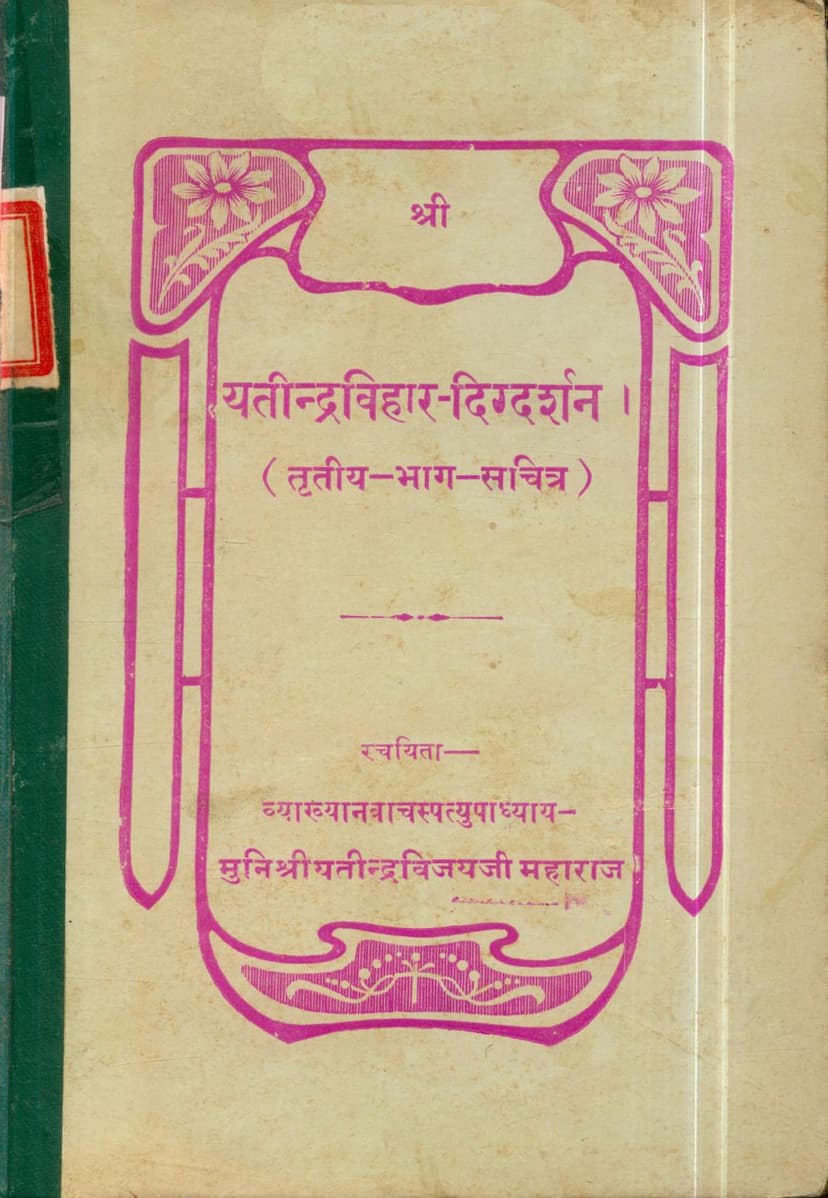Yatindravihar Digdarshan Part 03
Added to library: September 2, 2025

Summary
This document is the third volume of "Shree Yatindra Vihar Digdarshan" (श्री यतीन्द्रविहार-दिग्दर्शन), authored by Yatindravijayji Maharaj (यतीन्द्रविजयजी महाराज). The book, published by Saudharm Bruhat Tapagacchiya Shwetambar Jain Sangh, was printed in 1935 CE (Vikram Samvat 1991). It focuses on the travelogue and historical accounts of Jain pilgrimage sites, specifically detailing a journey or expedition related to the Kutch-Bhadreshwar Jain pilgrimage.
The volume begins with an introductory section that extols the virtues of traveling for spiritual and worldly knowledge, citing Jain scriptures. It emphasizes the importance of "Padavihar" (पादविहार) – traveling on foot – for Jain monks and nuns as a means of spreading Dharma and connecting with the populace. The author laments the decline in this practice due to perceived "shithilata" (शिथिलता) among some ascetics, which he believes has led to a stagnation and even decline in the Jain community's numbers compared to other religious groups. He advocates for greater cooperation and embracing of the masses by the monastic community to ensure the religion's growth and the ascetics' own spiritual progress.
The main body of the text then delves into a detailed account of a "Laghusangh" (लघुसंघ) – a smaller pilgrimage group – undertaking the journey to the Kutch-Bhadreshwar pilgrimage site. This journey began from Siddhakshetra-Palitana in Vikram Samvat 1990 (November 1933 CE). The group comprised three monks, four nuns, and approximately thirty lay followers from various regions of Marwar and Gujarat. The entire expense of the expedition, including transportation, accommodation, and food, was borne by Pratapchand Dhuraji Jain, a devout follower from Bagra, Marwar.
The book meticulously chronicles the group's itinerary, describing each village and town they visited en route. For each location, it provides:
- Historical context: Ancient and modern history, including the origin of place names.
- Geographical details: Location, nearby rivers, terrain.
- Jain community presence: Number of Jain households (distinguishing between various sects like Visa Oswal, Visa Shrimali, Dasa Shrimali, etc.), and their general disposition (devout, learned, or otherwise).
- Religious infrastructure: Details of Jin Mandirs (temples), Upashrayas (monasteries for monks and nuns), Dharmashalas (guest houses for pilgrims), and their architectural features.
- Inscriptions and historical records: Transcriptions and translations of inscriptions found in temples and on structures, providing details about their construction, donors, and the ascetics who consecrated them.
- Notable landmarks: Descriptions of specific temples, idols, ponds, and other significant sites.
The journey included extensive travel through regions of Gujarat and Kutch, covering numerous towns and villages. The text highlights the hospitality received from local Jain communities, the challenges of traveling through the Rann of Kutch (describing its harsh conditions, salt flats, and lack of water), and the devotional activities undertaken by the pilgrimage group, including temple worship, readings of scriptures, and Swamivatsalya (community meals).
A significant portion of the book is dedicated to Shri Girnar Mahatirtha (Girnar Hill) and the Shri Bhadreswar Tirth, detailing their history, significance, the various routes to ascend the hills, the numerous temples and deities present, and the spiritual merit associated with their pilgrimage. The text emphasizes the immense spiritual benefits of visiting these sacred sites.
The latter part of the book includes various "stavan" (स्तवन) or devotional hymns composed by the author and others, praising Jain Tirthankaras and the spiritual guides like Acharya Vijay Rajendrasuri and Yatindravijayji Maharaj. These hymns are presented in various traditional musical meters and poetic styles.
The appendices contain the Hindi translations of Sanskrit inscriptions found during the journey, providing further historical and religious context.
In essence, "Yatindra Vihar Digdarshan Part 03" serves as a comprehensive guide and devotional record of a significant Jain pilgrimage, rich in historical, geographical, and religious details, and infused with a deep reverence for Jainism and its practices. It also offers a socio-religious commentary on the state of the Jain community and monasticism during that period.